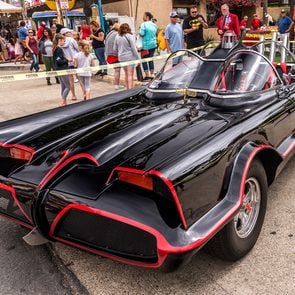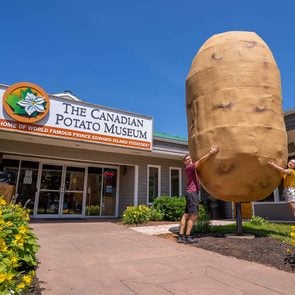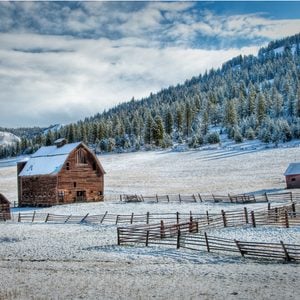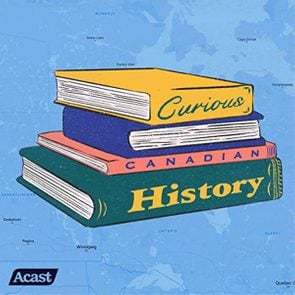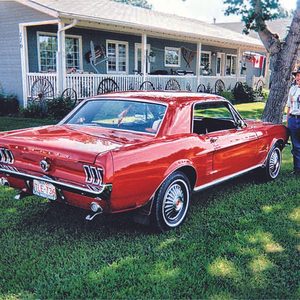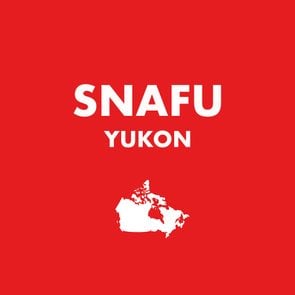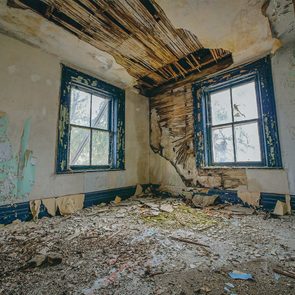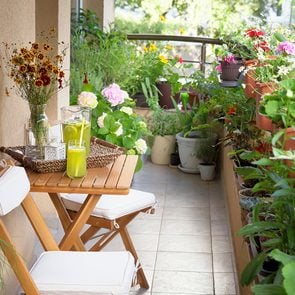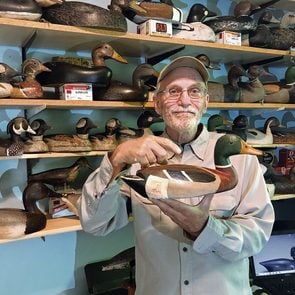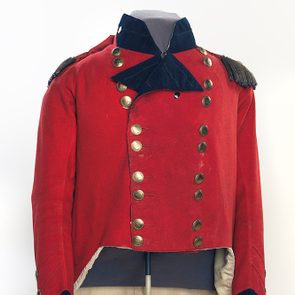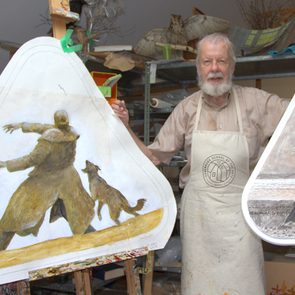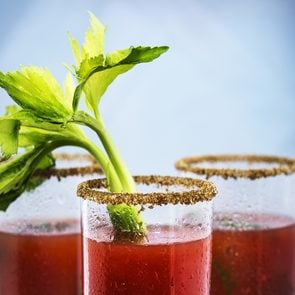There are lots of things to be grossed out about on airline flights. From tiny airplane bathrooms with toilets that hundreds of people use for hours without cleaning on a long-haul flight, to tray tables where people may have spilled food or changed diapers, there are plenty of places for germs to hang out. But the grossest part of your airplane seat, according to flight attendants, is actually someplace you might not suspect: the seat pocket in front of you.

Why is the seat pocket the dirtiest part of your airplane seat?
In a Reddit forum, someone asked flight attendants, “What are some disturbing secrets that passengers should know?” A veteran flight attendant, HausofDarling, recommended that “you never, ever, ever, EVER use or put anything in the seat pocket.”
The reason, they said, is that seat pockets are “cleared of rubbish but are never ‘cleaned.’ I have pulled out and seen all sorts [of things] pulled out from there. Dirty tissues, sick bags, knickers, socks, people’s feet, gum, half-sucked sweets, apple cores.” So, think twice before stashing your phone or laptop in there on your next flight.

What other parts of your airplane are dirty and gross?
Airplane cabins are basically like germ farms. In just eight hours, just one cell of E. coli can become a colony of more than 12 million cells. Your tray table alone likely has more germs than a toilet seat or a cell phone. For example, one study revealed that tray tables contained more than 2,000 colony-forming units of bacteria per square inch. To put that in perspective, swabs of cell phones have shown around 27 to 30 colony-forming units per square inch.
This is why experts say you should never take your shoes off on an airplane. A flight attendant recently told Mirror passengers should also avoid wearing shorts during flights, which he said was “a one-way ticket to bacteria-ville.” The flight attendant further warned against falling asleep or leaning your head on the window, since you have no idea how many people or children have wiped their hands (or other things) all over these surfaces.
How to clean your airplane seat
There is a right way to germ-proof your plane seat, however. Always bring antibacterial wipes that contain alcohol and are approved to actually kill bacteria. Wipe the tray table, the seatbelt handle, the armrest and recliner button, the area around the window, and even the air vents, according to Debra A. Goff, Pharm.D., an infectious disease specialist at Ohio State University.
Next, check out our ultimate guide to healthy travel for seniors.
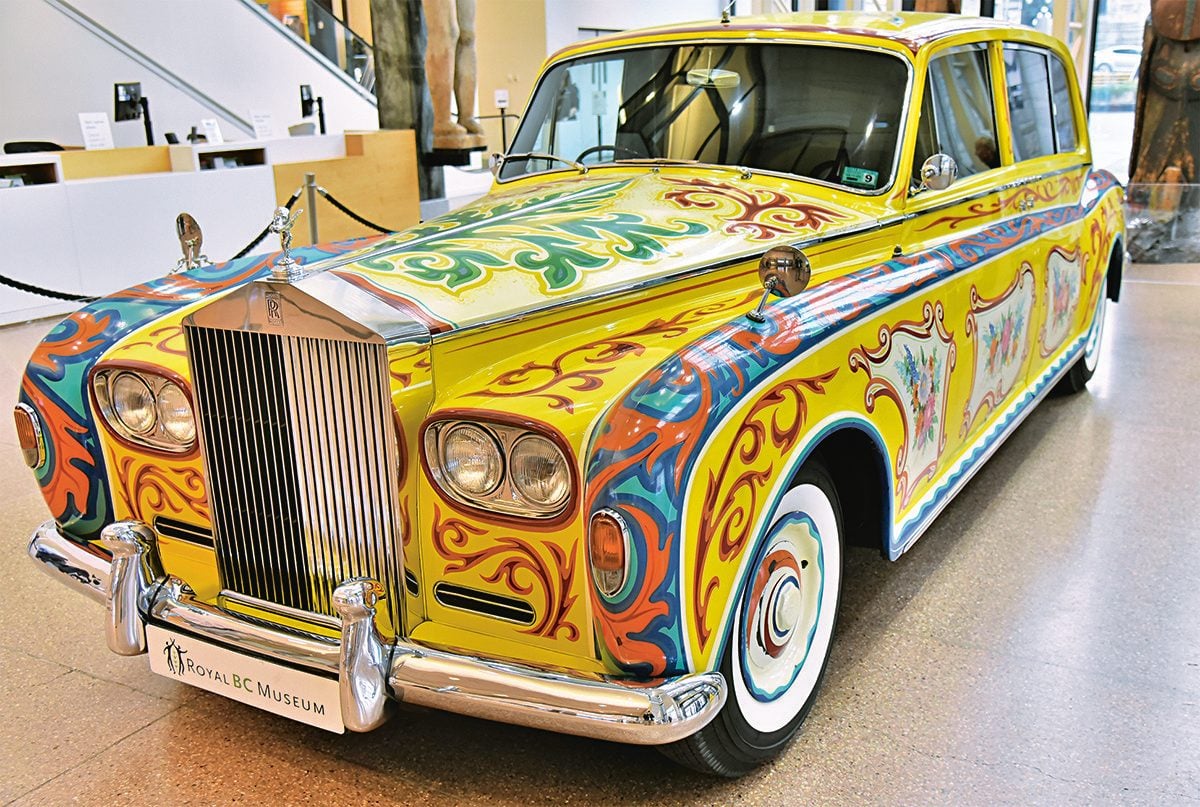
John Lennon’s Rolls Royce Limousine is a Psychedelic, Souped-Up Work of Art
Do you remember where you were on February 9, 1964? I do. I was 16 years old and living in West Vancouver. That evening, as my sister and I lay on the living room floor watching The Ed Sullivan Show, history was made. The Beatles performed live and the five songs they sang were burned into our collective consciousness. They played “All My Loving,” “Till There Was You,” “She Loves You,” “I Saw Her Standing There,” and “I Want to Hold Your Hand.”
What we saw on that black-and-white screen changed everything. The long hair, the infectious personalities, the sharp suits, the well-scrubbed faces, the audience of hysterical teenage girls, and the music… Beatlemania, broadcast live, right in our own home.
It was wonderful while it lasted. Now, the Beatles live on through their music—and some memorabilia that they left behind. One such piece of history is John Lennon’s Rolls Royce Phantom V Touring Limousine. Lennon commissioned additions to the 1965 classic such as a bed, custom paintwork and even a record player. The newly decorated yellow car was delivered to Lennon in 1967, just before the “Sgt. Pepper’s Lonely Hearts Club Band” album was released.
The Royal B.C. Museum in Victoria currently owns the iconic car. It was purchased at auction in 1985 for more than $2 million by Canadian businessman Jim Pattison. He donated the Rolls to the province in 1992. It has been in the museum collection for nearly 30 years, but is usually kept in storage. It was on display in the lobby in 2016, and again for one day only in 2017. In January 2020, it was free for viewing daily for about six weeks in the museum lobby. What a treat!
Check out more surprising treasures you’ll find in Canadian museums.
The First World War entered its third year in 1916, but the worst was yet to come for Canadian troops on the Western Front. More than 6,500 Canadians had been killed, captured or wounded in the Second Battle of Ypres in Belgium the previous May, a brutal event that also saw the first mass use of poison gas by the German Empire. While the demand for war supplies and a boom in agriculture meant that unemployment was virtually non-existent in Canada by 1916, the uncertainty surrounding the Great War weighed heavily on Canadians at home and abroad—many had initially expected it to be a short and cheap war.
And so, when a fire raged through the Parliament Building in Ottawa—one of Canada’s most enduring symbols—on the evening of Feb. 3, claiming seven lives and destroying most of the structure, it immediately came to be regarded as one of the darkest chapters in the country’s history.

Fire Breaks Out
The fire started at 8:37 p.m. in the Centre Block near the House of Commons. Francis Glass, an MP from Nova Scotia, was in the Reading Room when he noticed a pile of papers aflame. He quickly alerted a nearby constable, but because the room was lined with varnished wood panelling and filled with newspapers, the flames engulfed it within minutes. Meanwhile, in the House of Commons, MPs were in the middle of a debate. The topic? The high prices of fish.
A doorman rushed into the chamber and told everybody to evacuate; by then the fire had spread into the corridors. Thick, black smoke washed over the journalists seated in the press gallery. Sir Robert Borden, prime minister at the time, was in his office and reportedly made his way to the exit on his hands and knees. Amidst the pandemonium, it was George Adam Elliott, a farmer and MP from North Middlesex, Ontario, who pushed his colleagues to form a human chain to help others escape.
There was no stopping the fire, however. Staff members raced to save whatever objects they could. By midnight, the Centre Block’s Victoria Bell Tower collapsed. In the early hours of the morning, firefighters had the flames mostly under control, but the damage was done: thousands of historical records and treasures were destroyed and seven people had perished, including Bowman Brown Law, an MP from Yarmouth, Nova Scotia. Only the Library of Parliament remained, thanks to an iron fire door and a librarian who had the presence of mind to close it.
The Aftermath
“The loss the country felt must have been almost unimaginable,” Mark Bourrie, an Ottawa historian and author of Canada’s Parliament Buildings, said in 2019. “Something central to the soul of Canada was suddenly gone.” But the show went on—after all, Canada was at war. The next afternoon, while Parliament was still burning, Borden and his Cabinet met at the Fairmont Château Laurier and chose the Victoria Memorial Museum as a temporary chamber.
On Sept. 1, construction began on the new Parliament Building. The Centre Block would be one storey higher than the original, while its interior walls would be limestone and marble instead of flammable wood. Parliament Hill opened again on Feb. 6, 1920.

What Caused the Parliament Fire?
Though the exact cause of the 1916 Parliament Building fire was never determined, rumours circulated that it was not accidental, but the work of German saboteurs.
American historian Herbert von Feilitzsch is one of the theory’s supporters. According to the author of The Secret War on the United States in 1915, Germany had a standing order to attack Canada during the First World War. “That order was known to many Germans even along the border,” von Feilitzsch said in 2016. “The Germans were recruiting German-Americans and German-Canadians to do that.” If the Germans were indeed responsible for the fire, von Feilitzsch theorizes that saboteurs could have used a “pencil bomb,” a cigar-shaped explosive that could be set to detonate at any time; German agents used one such bomb to set fire to a munitions depot in New York Harbor later that year.
The mystery of the Parliament Building fire of 1916 may never be solved, but two things are certain: Canada emerged from the wreckage of the First World War victorious, and the rebuilt Parliament Building continues to stand tall over the southern banks of the Ottawa River. A massive renovation project was launched in 2002; the West Block was completed in 2018 and the Centre Block is expected to be finished after 2030.
“It is a national icon that needs to be protected,” minister of national defence Anita Anand said in 2021, “so that it can continue to serve our parliamentary democracy into the next century.”
Next, read the terrifying tale of the Great Matheson Fire—the worst forest fire in Canadian history.
Asparagus season brings many joys—whether sautéed, grilled, steamed or fresh, these succulent shoots are not only delicious, but one of the most nutritionally-balanced vegetables. Loaded with antioxidants and folate, asparagus also contains brain-boosting amino acids and even cancer-fighting compounds. There’s just one catch—it may give your pee an unholy stench.
This puzzling phenomenon has its basis in asparagusic acid, a unique chemical produced only by (you guessed it) asparagus. Your liver metabolizes it into sulfur-containing compounds that make their way through your kidneys to your bladder and out into the toilet bowl, thus infusing your pee with that characteristic rotten-egg bouquet. Our digestive and excretory systems are so efficient that it can take as little as 15 minutes for the smell to show up.
But scientists have discovered that not everyone is affected by asparagus pee in the same way, deepening a genetic mystery. In fact, as many as 6 in 10 people do not notice any change in their urine’s smell after eating asparagus, and the reason is intriguingly complex.
Why does asparagus make pee smell for some, but not others?
While asparagus’ pungent side-effect has been written about for hundreds of years—even Benjamin Franklin noted its “disagreeable odour” in 1781—earnest scientific inquiry into asparagus pee didn’t begin in until the 1950s, when Oxford University researchers found that 40 percent of their subjects excreted methanethiol (or methyl mercaptan), the infamous stink compound that also causes bad breath, after eating asparagus. Some didn’t produce any at all after eating as much as a pound in a sitting (lucky them).

Not everyone can smell asparagus pee
But in 2016, Harvard University scientists complicated the question with a study on “asparagus anosmia,” or the inability to smell asparagus metabolites in urine. In other words, the main variable is your nose, not what’s in your pee—and according to their research, 60 percent of the population can’t smell the distinctive tang, either in their own pee or that of a “known producer” (we hope participants in this study were well-compensated).
As many as 800 genes are thought to influence whether our smell receptors can pick up the specific compounds that produce the telltale stink. Based on a user survey, consumer genetic testing company 23andMe isolated a single mutation for smelling asparagus pee, which might be inherited (and could help you decide if you should serve asparagus quiche at your next family brunch).
So if you eat asparagus and don’t notice a change in the way your pee smells, can it still stink? Maybe. Some scientists say people vary in their ability to both produce asparagus pee and their ability to smell it. In other words, we can be stinkers, sniffers, both, or neither.
Broader implications
No matter which tribe you belong to, you might be curious what all this can tell us about the differences in the way our bodies work, and what that might mean for our health. If certain foods can make your pee smell, could they also influence your risk for inflammation or cancer? One emerging field of study, nutrigenomics, is based on the relationship between food and our genome, and companies have sprung up offering personalized testing to find out which foods you should eat to optimize your health according to your unique genetic profile.
Toronto-based Nutrigenomix, for example, offers testing for a variety of genes, from your heart disease risk to your propensity for weight gain, and provides customized nutrition advice based on the results. The problem is, some skeptics say, there’s no guarantee that it will work.
“Your risk of heart disease can be altered by multiple gene variants,” says Montreal cardiologist Dr. Christopher Labos. “The claim that you can determine your risk from one test is very, very dubious.”
What’s more, whatever your results, your dietary recommendations will probably be the same, says Labos. “If we all ate more fruits and vegetables, less processed food and more whole grains, we’d all be a lot healthier,” he says. “We don’t need genetic testing to tell us that.”
One thing’s for sure—stinky pee or no, if you’re eating lots of asparagus, you’re doing something right.
Now that you know why asparagus makes your pee smell, find out the surprising things your poop can reveal about your health.

I always thought of my husband’s highland green ’68 Mustang Fastback as our “honeymoon car,” but the rest of the world knew that make and model as the Bullitt Mustang from the 1968 Steve McQueen movie.
My Steve purchased his Mustang after receiving a tip from my father that there was a nice sports car for sale at a body shop in Goderich, Ontario. A couple of years later, in the summer of 1973, we prepared to head out in it for a two-week tour of the province. Cheered on by waves and well wishers after our wedding reception, a quick beep signalled the beginning of a carefree road trip.

Movie camera in hand, we captured footage of the cottage we stayed at in Thunder Beach, as well as time spent in Ottawa, Orillia, Sharbot Lake Provincial Park, Toronto’s Ontario Place and Niagara Falls. In scenes from the film, you can easily spot the car. We loved it, and Steve kept it pristine. When he drove it, I thought he looked mighty handsome! With its 289 cubic-inch engine, automatic transmission and two-tone green interior, it was definitely a show stopper!
Fast forward a year after our honeymoon, and we were blessed with a precious son. As time went on, I was finding it very difficult to get our little bundle into the back baby seat. Mustangs weren’t made for transporting babies along with their accoutrements! After much discussion, it was mutually agreed that a family type vehicle would be more helpful, and feeling melancholy, Steve drove his Fastback up to the local Ford dealer, “Green and Parent”, in Goderich, to trade in for a van.
A week later, filled with regret, he returned to the dealership to buy it back. He said we’d figure out the money somehow, but to his dismay, it had already been sold. Years passed, and one day while again lamenting our decision to let it go, I wrote a letter to the local paper, in an attempt to track it down, but to no avail.
Undeterred, we always kept our eye out for the car, or at least the same model to purchase, but as time went by, and its popularity grew, that sought-after Mustang’s price tag was far beyond our means. Buying a home and raising three children had become our family focus.
The summer of 2023 will mark our 50th wedding anniversary, so here’s hoping someone reads our story, and can identify the vehicle’s whereabouts. Although we realize “that ship has sailed”, as far as the chances of owning our honeymoon car again, we’d sure be happy just to know what happened to it!
Cindy and Steve would love to know the whereabouts of their beloved “honeymoon car.” Can you help?
Fast facts:
1968 Ford Mustang Fastback, Model 8F02C, Serial No. 209294; highland green paint job, two-tone green interior; traded in with 62,554 on the odometer on June 25, 1975, at Green & Parent Ford Mercury Sales Limited, Goderich, Ontario.
Share any leads you might have at the Our Canada submissions page and we’ll pass it along!
Next, find out how the Mustang became a cultural icon.

Knock Knock Jokes That Have Us Laughing Every Time!
Knock, knock.
Who’s there?
A little old lady.
A little old lady who?
I had no idea you could yodel!
—@KnockKnockJokes

Knock, knock.
Who’s there?
To.
To who?
To whom.
—Reddit.com

Knock, knock.
Who’s there?
Saul.
Saul who?
Saul there is. There ain’t no more.
—Fletcher Henderson, 1930s big-band leader

Knock, knock.
Who’s there?
Ida.
Ida who?
Surely it’s pronounced Idaho?
—@haileyhargreeve

Knock, knock.
Who’s there?
A broken pencil.
A broken pencil who?
Never mind. It’s pointless.
—@BiarianaCxH

Knock, knock.
Who’s there?
Nobel.
Nobel who?
No bell. That’s why I knocked.
—LaughFactory.com

Knock, knock.
Who’s there?
Boo.
Boo who?
Hey, don’t cry!
—@kata_kitoka

Knock, knock.
Who’s there?
Luke.
Luke who?
Luke through the peephole and find out.
—Parade.com

Moo.
Knock, knock.
Who’s there?
Time-travelling cow.
—@LeahBloom

Knock, knock.
Who’s there?
Control Freak.
Con…
Okay, now you say, “Control Freak who?”
—Aoibhinn Ní Shúilleabháin, broadcaster

Knock, knock.
Who’s there?
Leon.
Leon who?
Leon me … when you’re not strong!
—Fatherly.com

Knock, knock.
Who’s there?
Police.
Police who?
Police hurry up, it’s nearly lunch time!
—@TheStourbridge

Knock, knock.
Who’s there?
Hatch.
Hatch who?
Bless you.
—LaughFactory.com

Knock, knock.
Who’s there?
Van Nuys.
Van Nuys who?
Van Nuys was 17, it was a very good year…
—@KnockKnockAtoZ

Knock, knock.
Who’s there?
Honeydew.
Honeydew who?
Honeydew you wanna dance?
—Bestlifeonline.com

Knock, knock.
Who’s there?
KGB.
KGB who?
We will ask the questions!
—Dwight Schrute, The Office
Don’t miss these hilarious quotes from The Office!

Knock, knock.
Who’s there?
Cows go.
Cows go who?
No, silly. Cows go moo!
—Reddit.com

Knock, knock.
Who’s there?
Elly.
Elly who?
Elly-mentary, my dear Watson!
—@ItsJohnathan91

Knock, knock.
Who’s there?
Cash.
Cash who?
No thanks, I’ll have some peanuts.
—ThoughtCatalog.com

Knock, knock.
Who’s there?
Owls.
Owls who?
They sure do!
—Reddit.com

Knock, knock.
Who’s there?
Ice cream.
Ice cream who?
Ice cream if you don’t let me in!
—@StumpyCatBooks

Knock, knock.
Who’s there?
Dejav.
Dejav who?
Knock, knock.
—Fatherly.com

Knock, knock.
Who’s there?
Euripides.
Euripides who?
Euripides clothes, you pay for them!
—Parade.com

Knock, knock.
Who’s there?
A wood wok.
A wood wok who?
A wood wok 500 miles, and a wood wok 500 more!
—Reddit.com

Knock, knock.
Who’s there?
Spell.
Spell who?
Okay, fine. W-H-O.
—Bestlifeonline.com
If you enjoyed this roundup of the best knock knock jokes, be sure to check out our all-time favourite wedding jokes.
Near the end of my first summer away from home, I went with my older brother to visit a man who might have a place to rent. He was a sort of hermit, we had been told, and lived in the woods near Port Edward, B.C., south of Prince Rupert. My brother and I were working at the pulp mill and had been living in a trailer in Port Edward for the summer, but the owners had just returned from a long sailing trip, so we had to find other accommodations.
The first sight of our prospective landlord gave us a shock. He emerged from his weathered little cabin as if he had been roused from sleep, though it was midday. Stubble-faced, shirtless, with a pink stump where his right arm should be and a long white scar tracing a crescent across his massive belly, he greeted us affably enough.
We tried to ignore the stains of egg yolks, grease and who knows what else on his shabby trousers and accepted his invitation to look around.
The little shack had four rooms: two bedrooms with a woodstove in each, a tiny porch where firewood was stored and a dog lived, and a tiny washroom. Both bedrooms were cluttered and filthy, but at least the hovel had running water and inside plumbing. The windows were covered with plastic and each bedroom had a sagging bed, a couple of shelves, a table and two chairs.
“There’s lots of scrap wood lyin’ around that you can burn, and you can borrow my wheelbarrow,” the man said, gesturing with his good arm. “It’s not much of a place, but you can have it for 50 bucks for two weeks.”
My brother and I looked at each other, then nodded. The price was right and soon we’d be back in the Fraser Valley.
So we moved in, uneasy about the prospect of sharing a house with this sloppy old hermit, but intrigued by the challenge. Cleaning our bedroom was a daunting task, but after we had tossed out the refuse of the previous tenant, lined the shelves with newspapers, stored our few belongings and lit a fire, it started to feel like home.
Tea and Comfort
Our landlord’s name was Romeo Davignon, we learned, but he kept pretty much to himself until my brother left to return to the University of B.C. During the 10 days or so that I remained in the cabin, Romeo began to seek out my companionship.
“When you get back from work tomorrow, why don’t you join me for a cuppa tea?” he suggested. So I did.
I had worked the graveyard shift at the pulp mill and after walking about a mile to the little cabin in the woods, I was ready for a cup of tea.
When Romeo invited me into his part of the cabin, I couldn’t help noticing how soiled his bedsheets were. Romeo put an old black kettle on the stove and set out two cups, one of them chipped. While the water boiled, he sliced a loaf of bread. I watched, fascinated, as he pinned the loaf to the cutting board with the stump of his right arm, then sliced it using his left hand.
Despite the squalid surroundings and my host’s slovenly appearance, the tea tasted fine, and so did the toast and jam. Romeo was a laconic man, but glimpses of his life emerged as I had tea with him almost every day during my short stay in his cabin. He was a former boxer from Montreal who had lost his arm in a railway accident, I learned. A friend sometimes took him deer hunting—how proud he was of being able to pull the trigger with his left hand while pressing the rifle against a tree with his stump of an arm. Sometimes he supplemented his pension by selling postcards on the streets of Prince Rupert, he confided.
Once he proudly showed me how he had rigged up a series of pipes to provide hot water from the heat of the woodstoves. It was an impressive feat of plumbing and I was quick to say so; how he managed it with one hand was beyond me.
Romeo smoked incessantly, rolling his own with the aid of a little device, and I was afraid he’d burn the place down, but the cabin was always there when I returned from work.
Simple as it was, it was a cosy little haven, especially when I walked through the dark woods after midnight at the end of an afternoon shift. There was no lock on the door, but my possessions were never disturbed and I felt quite safe there, warmed by the stove, hearing the relentless Prince Rupert rain drum against the tin roof and the wind buckle the plastic windows. I read letters from home by the light of a single bulb that swung from a long cord above my bed.
One evening, Romeo had visitors, a girl of about nine and her brother, probably a couple of years older. I remember the girl had beautiful long hair and big, dark eyes; she let her brother do most of the talking but she seemed fascinated by Romeo. I never did learn what had prompted them to visit the lonely old man or if they were related to him in some way.
On my last night there, I lay on my bed reading all the letters I’d received from family members and friends during the summer. I was 900 miles away from home and the letters made me feel nostalgic, but I burned all the letters in the woodstove as I’d soon be seeing these people again in person.

Without a Trace
As for Romeo, I never met him again, nor did I try to keep in touch. Three summers later, I worked as a porter on the Canadian National Railway. On a weekend layover in Prince Rupert, my friend Al and I walked all the way from Prince Rupert along the railway tracks to Port Edward, then up the hill into the woods.
How surprised Romeo would be when I dropped in, I thought, but when I got to the cabin, it was gutted and bare. The outside was as I’d remembered it—red siding on “my” side, cedar shakes on his—but the interior had been charred by fire.
Had his constant smoking caused the fire, I wondered, and where was he now?
This was all more than 50 years ago, but once in awhile, when it’s rainy or windy, I’m transported to that little shack in the woods, watching Romeo pin the loaf of bread to the cutting board with his stump and handing me a hot cup of tea in a chipped mug as he asked, “So how was your shift today?”
Next, take a look in at Bradian, B.C.’s most famous ghost town.

Summer is here, and that means it’s container gardening season! While growing your favourite annuals in pots can make your yard look gorgeous and colourful, it can also be an expensive process—and some of that involves the cost of soil.
Believe it or not, a simple household item—the humble pool noodle—can cut down the cost of soil as well as improve drainage in your container plantings.
Why you should add pool noodles to your planter pots
@pennyjo8 I do this Dollar Tree pool noodle planter hack every year in all of my big planters. Potting soil isnt cheap yall lol This allows for drainage and use of half the amount of soul you normally would use. #planterhacks #planterhack #gardenhack #hacks #plantsoftiktok #flowers #gardening #diy ♬ THEY ARE GONNA KNOW – Heliqs
As seen in this TikTok by creator @pennyjo8, begin by cutting pool noodles to approximately 3/4 of the height of your plant container. Then, stand the pool noodles vertically in the bottom of the planter until it’s filled, and scatter the soil mix over them. Instead of trying to clump the soil, allow it to fill in and around the noodles before evening it out with your hands. A gentle tap can also help to level the soil.
@pennyjo8 then shows us a shot of the planter with flowers in it—and as you can see, there’s no hint of the buried pool noodles. (Adding trailing plants like ivy or vinca vines to spill over the side can also help cover up the pool noodles if you’re worried about shifting soil.)
How does this help?
Pool noodles help with container gardening in a couple of ways. A pot that is overly dense with soil can lead to one of the biggest concerns for planter pots: poor drainage. The pool noodles keep water flowing through the soil, reducing the risk of root rot. What’s more, the fact that the bulk of the pot is filled with pool noodles (rather than potting soil) delivers a number of benefits. Not only will you save a bundle on soil at the garden centre, you’ll also find it’s much easier to move the pot around your porch, patio or balcony than if it was completely filled with water-logged potting mix.
Using this helpful gardening tip at the beginning of the season will help keep your plants thriving all summer long.
As international events were building towards the Second World War, a small group of artists from Montreal decided to merge their creative forces and incorporate as a company to earn their keep while expanding their knowledge of art and sculpture. And so Rémi Arbour, Henri Bélisle, Fleurimond Constantineau, Armand Filion and Louis Parent, all graduates of the Montreal School of Fine Arts, banded together to form La Maîtrise d’Arts, also fondly known by many as the “The Group of Five.”

The Group of Five
All five were gifted painters who wanted to expand their horizons and explore other mediums as well. Arbour, Bélisle and Parent became fascinated with pottery, while Constantineau and Filion found a unique challenge in creating large-scale allegorical floats for Montreal’s St. Jean Baptiste parade, held on June 24 every year. The five men developed a close friendship over the years, collaborating on projects and helping one another at every opportunity.

The Group of Five first began to work on the St. Jean Baptiste parade in 1932. The City of Montreal lent them a brand new warehouse in the Chabanel district to use as a workshop. The floats could not be more than 16 feet high, because overhead electrical wires along the parade route were hung at 18 feet, but tended to droop in hot weather. The parade attracted thousands of spectators, all standing along the streets, clapping in celebration as historic representations of French Canada streamed by with much fanfare every summer. The ornate horse-drawn parade carriages were a joy to behold and a triumph for everyone who had worked on them.

Lions for King George VI
In May 1939, King of England George VI and Queen Elizabeth came to Canada on a Royal Visit, the first British monarchs to ever do so. A stop-over and parade in Montreal was on the itinerary for their national rail tour, undertaken largely in support of the war conscription movement. To properly welcome these distinguished guests, many Quebec artists were asked to work on various themes and motifs for display along the Royals’ parade route.
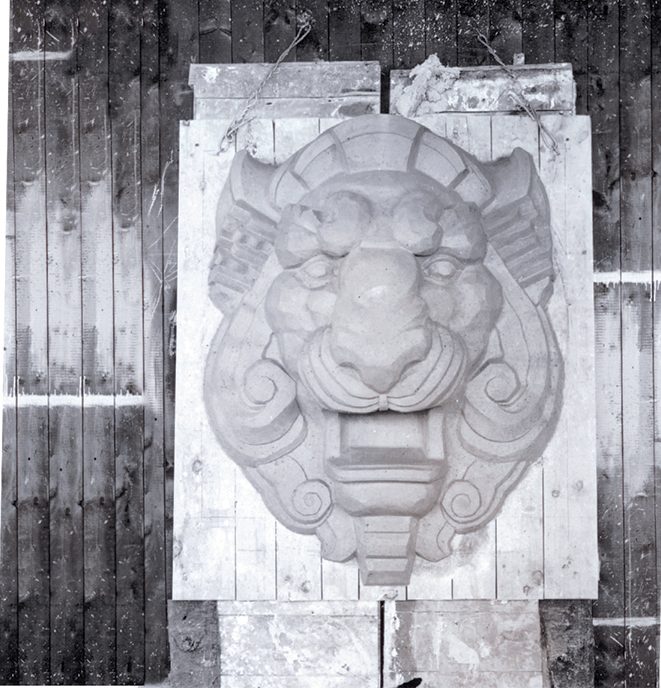
La Maîtrise d’Arts was invited to produce a set of lions, which were to be part of a street archway. Sculpted with an artistic flair, the lions were then plaster-cast by Carli-Petrucci, Montreal statuary makers who had been in business for over a century. The Royals’ 1939 tour through Montreal was a truly remarkable event in our history, creating countless memories—and opportunities for artists and artisans to apply their talents in creative ways. For those of us who love to haunt local thrift stores, flea markets and antique shops, finding artistically crafted memorabilia from that event and time period is always a joy!
Take a look back at the most memorable royal visits to Canada.

Pottery on Île Sainte-Hélène
While contributing their skills in sculpting to the Group of Five’s parade efforts, Rémi Arbour, Louis Parent and Henri Bélisle were focusing increasingly on their passion for pottery. They badly needed their own workshop to experiment and create in, and seized upon an opportunity to work inside the old stone fort on St. Helen’s Island under the Jacques-Cartier Bridge. On Friday, September 1, 1939, the programming on Canadian radio stations was interrupted with news of Hitler’s sudden attack in Poland, resulting in anguish and rapidly changing circumstances across the country and throughout the world. When word came that the old fort was to be returned to its original purpose as a military facility, La Maîtrise d’Arts had to move, and quickly.
Born in the rural town of St. Julienne, Henri had just finished building a new house in the Ahuntsic district of Montreal, working with his uncle Wilfrid—who specialized in building barns. Henri designed his house to suit his needs as an artist, keeping the best and largest areas for artistic purposes, and choosing to sleep in a tiny room. Upstairs, he enjoyed a spacious and bright studio, while the basement housed his pottery oven. A room on the first floor was used to prepare the glazes, and a showroom was set up in the living room, where his partner Louis would give presentations to visitors about ceramics and casting, telling them about the main steps from A to Z. Members of The Youth Chamber of Commerce of Montreal, then numbering around 80, would visit Henri’s house from time to time for guided tours.
Henri sometimes hosted gatherings in his studio for his La Maîtrise d’Arts colleagues and friends. One night, someone brought over acclaimed violinist Arthur Leblanc of New Brunswick. Henri’s entire home vibrated with beauty that evening as Mr. Leblanc played his 1733 Stradivarius within what proved to be the studio’s ideal acoustic conditions.
Lasting Legacy
The creations of La Maîtrise d’Arts covered quite a large spectrum. For example, they designed an Art Déco thumb rest beer stein, which, in the 1940s, was to be sold at Morgan’s, and Birks, in downtown Montreal. Reproductions of this original mug are still on the market today, and are among our collections here at La Belle Amérique. They produced many other styles of beer steins, as well as vases and hand-turned pottery created by Louis Parent, who had studied pottery in Philadelphia in the mid-1930s. In addition to his artistic contributions, Louis was also the businessman of the Group of Five.

In 1941, the artists were commissioned by the HEC Business School museum in Montreal to produce figurines of Quebec’s various cow species; sculpted in clay, the pieces were then plaster-cast by Carli-Petrucci and afterwards hand-painted by the artists and put on display. That same year, La Maîtrise d’Arts was also asked to create the stage design for a special theater production put on by Les Compagnons de Saint Laurent, an acting company that were performing at the fabled Montreal Forum. According to the theatre critic of La Presse, the artists created an astonishing design in the style of France’s Chartres Cathedral, featuring “a very nice perspective.”
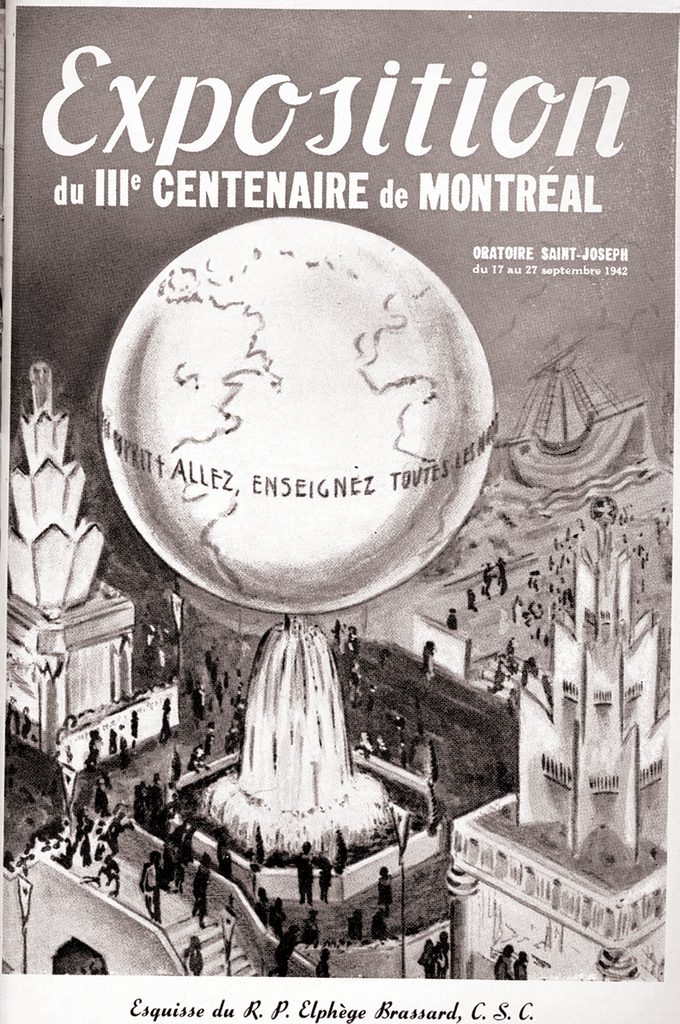
The following year was a big one for La Maîtrise d’Arts. To help commemorate Montreal’s 300th anniversary (1642-1942), they were asked to create a huge sphere for an exhibition held at St. Joseph’s Oratory, based on the theme of Canadian missionaries helping others worldwide. A team of artists and craftsmen agreed to work on the project, including a young Charles Daudelin, who would later become a distinguished sculptor. The sphere was hung by steel cables, using a 20 horse-power motor. When the structure was complete and opened for viewing, visitors were astonished at the sight standing before them on the Oratory grounds.
The Group of Five is now a treasured part of our archives, and I find it heartening to know that the artists’ creations are still being enjoyed in many homes to this very day. Also, because of their combined volume of work, those “rare finds” in thrift stores or flea markets you sometimes hear about have been known to actually come about with respect to the work of La Maîtrise d’Arts. So, keep your eyes open and perhaps you will be the next lucky person to find one of the group’s artistic treasures at an affordable price.
Find out more about Hélène’s passion for art history at La Belle Amerique.
Can’t get enough Canadian Collectibles? Check out the Blue Mountain Pottery story.

The Taco Origin Story
It’s believed the word “taco” comes from the Aztec tlahco, which means “half” or “in the middle.” According to Jeffrey Pilcher, author of Planet Taco: A Global History of Mexican Food (and a leading expert on the topic), the Aztec ruler Moctezuma II Xocoyotzin used tortillas prepared on hot stones as spoons to hold food.
But the modern moniker can be traced back to Mexican silver miners in the 18th century; taco was the word for the thin sheets of paper wrapped around the gunpowder used to excavate ore.
A working-class food in Mexico, tacos were brought to America when Mexican immigrants came to work in its mines and build its railroads. First mentioned in an American newspaper in 1905, the taco was an affordable item sold by street vendors in the Southwest.
The first taco-dedicated restaurant in the United States, El Cholo, opened in Los Angeles in 1923, but tacos didn’t become mainstream until Taco Bell started up in 1962. Its crispy-shell version, created for the Anglo palate, became widely popular, and the fast-food chain has since opened more than 7,000 locations in countries including Japan, Saudi Arabia and India. (It has no presence in Norway, but that could one day change, thanks to a Facebook campaign called “Get Taco Bell to Norway.”)
Authentic Mexican tacos use fresh tortillas made from ground corn or wheat, depending on the region. Though corn plays an integral role in Mexican culture the invading Spanish looked down on such native foods, which they associated with “heathen” deities. They favoured wheat, since it was linked with the Holy Eucharist.
As for the fillings? The many regional variations—from barbacoa (barbecued meat) to carne asada (steak) to nopal (cactus), to name only a few—have been influenced by history. The Spaniards, for example, introduced pigs, which led to Yucatán’s cochinita pibil (slow-cooked pork) taco. Head to Mexico’s Pacific coast and you’ll find tacos de pescado (fish tacos).

What about that delicious staple on any taco menu, tacos al pastor (“shepherd’s taco”), made with pork and pineapple? When Lebanese immigrants came to Mexico in the early 20th century, they brought their shawarma tradition and vertical rotisseries. The lamb they had used for gyros and kebabs was substituted with more widely available pork and pineapple.
Tacos are a messy, delicious creation. They may be stewed in tradition, but they can be whatever you want them to be. On Taco Tuesdays, North American families make them with store-bought crispy taco shells stuffed with ground beef, grated cheese and lettuce. The “taco night” practice has crossed the Atlantic to Scandinavia—except it’s on Fridays. In Sweden it’s called Tacofredag, and favourite toppings are yogourt sauces, pineapple, nuts and cucumber.
Clearly, the versatile taco can be filled to suit any palate.
Next, check out the hottest hot sauce you can buy.




